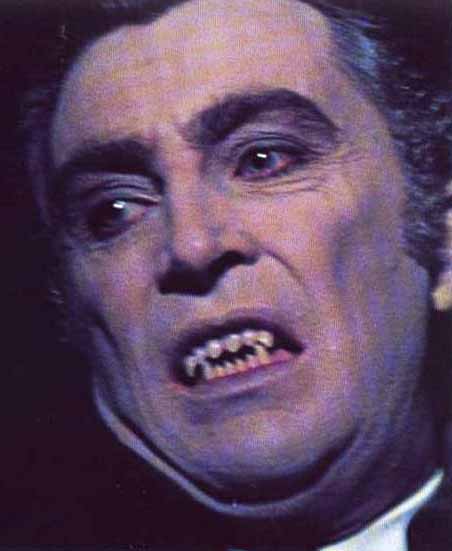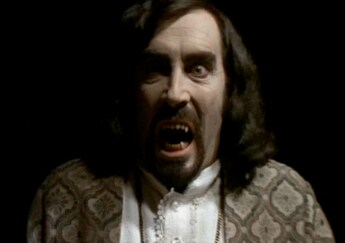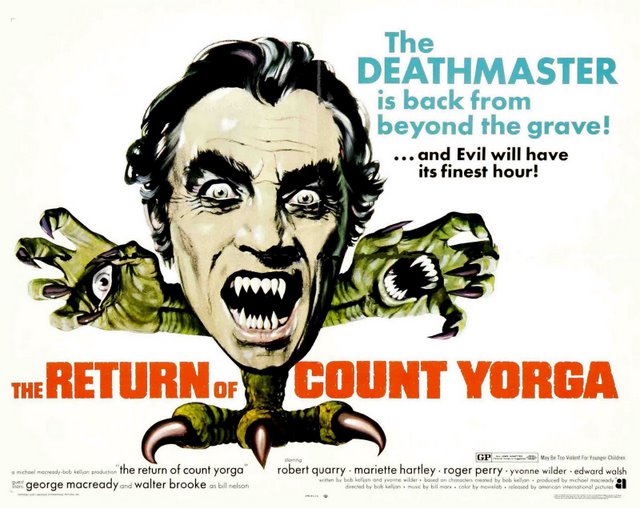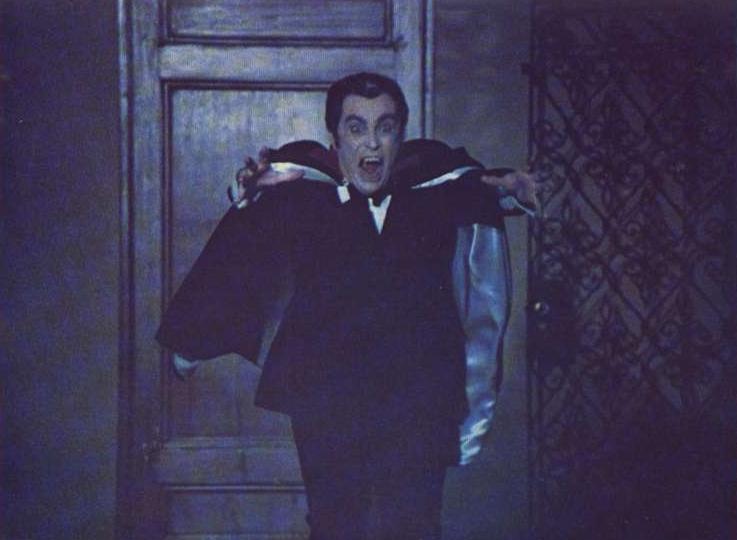 Count Yorga is a minor but amusing cult character, the subject of two low-budget exploitation films in the early 1970s entitled COUNT YORGA – VAMPIRE and THE RETURN OF COUNT YORGA. Although obviously patterned after Count Dracula, Yorga is very much his own bloodsucker, a rather sarcastic and condescending vampire. The two Yorga titles are notable for being among the best early attempts at transferring the vampire theme into a (then-contemporary) 20th Century setting. This they achieve (while avoiding the potential for audience derision) by adopting a certain tongue-in-cheek attitude, which at times (especially in the second film) approaches camp. Much of the success of the films belongs to actor Robert Quarry, who brought the modern day vampire to life with utterly condescending conviction, coupled with a ruthless sarcasm.
Count Yorga is a minor but amusing cult character, the subject of two low-budget exploitation films in the early 1970s entitled COUNT YORGA – VAMPIRE and THE RETURN OF COUNT YORGA. Although obviously patterned after Count Dracula, Yorga is very much his own bloodsucker, a rather sarcastic and condescending vampire. The two Yorga titles are notable for being among the best early attempts at transferring the vampire theme into a (then-contemporary) 20th Century setting. This they achieve (while avoiding the potential for audience derision) by adopting a certain tongue-in-cheek attitude, which at times (especially in the second film) approaches camp. Much of the success of the films belongs to actor Robert Quarry, who brought the modern day vampire to life with utterly condescending conviction, coupled with a ruthless sarcasm.
On the strength of COUNT YORGA, VAMPIRE, which was picked up for distribution by American International Pictures, the actor landed a contract with AIP, which produced this sequel and also cast him opposite Vincent Price in DR PHIBES RISES AGAIN (1971) and MADHOUSE (1973). Quarry was being groomed to replace Price as AIP’s in-house horror star; unfortunately for him, the horror cycle died out soon thereafter, as AIP moved into making blaxploitation films instead of horror. It was an unkind fate for an actor who could have joined the pantheon of great horror movie actors – and would have done so quite willingly. Unlike many stars trapped in the genre, Quarry is a fan who enjoyed horror, as long as it was achieved with a little style.
On Saturday, December 4, 2004, the Count rose from the grave and made an appearance in Hollywood’s Egyptian Theatre. Well, actually, actor Robert Quarry, who played Yorga, showed up to answer questions and sign autographs in between a double bill of the two Yorga films.
In his 70s, Quarry’s last credit (according to the Internet Movie Database) was 1999’s FUGITIVE MIND, but he was still dapper and healthy-looking when making appearances at fan conventions. He had recently been interviewed by Tim Sullivan for his “Shock and Roll” column at the Upcoming Horror Movies website. Writer-director Frank Darabont (THE MIST) read the interview and called to say he was a fan, then invited Quarry to attend the 10th anniversary screening of Darabont’s film THE SHAWSHANK REDEMPTION. Next, Sullivan and Darabont arranged with the American Cinematheque for the special double-bill Yorga tribute to Quarry in the Egyptian Theatre.
In between the two films, Sullivan and Darabont moderated a discussion with Quarry, who remains an engaging and amusing speaker – a rare actor not ashamed of his association with the horror genre, and one not afraid to poke fun at himself or take a stab at his former colleagues when the occasion demands.
The trio began with a discussion of how the first YORGA film came to be made: Producer Michael Macready (son of 1940s film heavy George Macready, who reads the film’s opening narration) and writer-director Bob Kelljan thought they could turn a profit by making a low-budget, soft-core horror film, called THE LOVES OF COUNT IORGA. Some of that soft-core sensibility remains in the final film, in muted form: Yorga gets off by watching his vampire brides make out; one of his victims, in anticipation of his arrival, works herself up into a state of sexual excitement by massaging her breasts; etc.
“They asked me to read the script,” Quarry recalled. “I said why don’t you just make a regular horror film out of it? They said will you do it? Of course I said yes, if it’s going to be a straight horror film. So you notice several places in the movie — in case it didn’t sell as a horror film — they left places where they could add whatever was necessary — two more breasts, or whatever.”
At the time, Quarry was placing a supporting role in WUSA, a film starring his friend Paul Newman. This created scheduling conflicts: his scenes had to be filmed at night anyway (after all he was playing a vampire), and he could only work on weekends. Inevitably, this led to some problems.
“I quit the first night,” Quarry said. “They called me at 12:30 in the afternoon. We were on location in Agora [a fairly isolated area northwest of Los Angeles], where it was about 110 degrees. So I got there and put on all that vampire drag. I sat there, and waited, and waited. They said, ‘We can’t shoot you until the sun goes down.’ I thought, ‘Well, why did you call me at 12:30?’ So I sat there patiently and ate some cold pizza. Around four o’clock in the morning, I was called to come on the set. The first shot that I did was where the kids were in the station wagon or whatever you call it, and my feet walk across the grass. The director said, ‘Cut, that’s a print. That’s it for the day.’ I stormed off into the night — I was making a lousy exit, was what I was doing. I got out into the night, and I got lost. They came by in a car and said, ‘Do you want a ride?’ I said, ‘No, I’m quitting this movie! I’m going home and I’m never coming back.’ They said it was a mistake, so I said, ‘Okay, you get your act together, and I’ll come back.’ Once I got off my high horse, we got to working together. But it was hard work. We had just four crewmembers — that’s it. They were all happy on plum wine and grass! There was one make-up man and a few guys with little arc lights. You say the film was ‘dark and mysterious’ — the film was dark and mysterious because we didn’t have enough lights!”
The resulting film, which cost less than $100,000, made several million dollars when American International purchased and released it. “We were truly the SPONGEBOB of 1969,” said Quarry, referring to the high profit-to-cost ratio of both COUNT YORGA, VAMPIRE and THE SPONGEBOB SQUAREPANTS MOVIE.
AIP slightly recut the film for release, and executive Samuel Z. Arkoff insisted on changing the title to make it easier for ticket buyers to pronounce. Quarry explained: “Sam said, ‘If it’s I-O-R-G-A, no one will know what it is,’ and he was probably right. But for the next five years of my life, he always called me ‘Count Yorba.’ I thought, ‘This thing made a little money for you – at least get the name right!’ They changed the name for him, but he still couldn’t get it right!”
THE RETURN OF COUNT YORGA is a more polished film, which emphasizes a slightly more overt form of humor than the first film. As in the first film, Quarry had to deal with dialogue delivered through Yorga’s over-sized fangs. “I was the first vampire to have upper and lower teeth — that was a big innovation in those days! They only had two eyeteeth in the Hammer films. My dentist gave them to me – I had a wonderful dentist who made them. There was only one problem: I couldn’t talk with them. In the first movie there was a line…’Soon I will suck from your veins the sweet nectar of your soul. Then we shall be as one — a lifetime of eternal bliss.’ That’s a handful to get your mouth around, but with the teeth it came out like, ‘Thoon I will thuck from your veinth the thweet nectar of your thoul…’ That got cut out!” The line found its way into the second YORGA script – but got cut out again, for the same reason.
Fortunately, the fangs only appear when Yorga attacks, leaving the actor free to speak most of his dialogue without lisping. In a nice touch, the actor managed to avoid sounding American without resorting to a clichéd Central European accent.
Quarry recalled: “When we first discussed the picture, I asked if they wanted [me to sound like Bela Lugosi saying] ‘Ah, the Children of the Night…” I didn’t want to do that, but I could get some kind of European thing going. So I learned the whole part with an accent, with a dialect, and then just took it out. As a kid from California I had worked very hard with a good voice coach to learn that ‘transatlantic’ accent, so I could play something besides Kansas City or Brooklyn. I started with a voice in a register up [high], and I had to get it lower to work on the thing. Christopher Lee is still working on it!”
Lisping dialogue and transatlantic accents were not the only – or even the greatest – challenges of the two YORGA movies. According to Quarry, “The hardest thing was being put in that coffin and having the lid lowered down on my face,” Quarry said. “That was really tough, because I’m a little claustrophobic. Boom, down came the lid, sitting on my nose, and I thought, ‘God, get me out of here!’”
Being exploitation films, YORGA efforts have their share of crude touches and horror movie clichés. For some reason, the impeccable Count (who lives in a very expensive-looking mansions in both films) keeps an extremely shabby-looking, hulking butler with a slightly deformed face.
“Here we are in this house all done up, and there’s this incredible looking thing over there,” laughed Quarry, referring to Brudah (Edward Walsh) and his tattered clothing. “I kept telling the director, ‘Can’t I take him to Sears for a new suit? We’ll all chip in and dress him up a little bit.’”
 Despite the success of the first two YORGA films, there never was a third. However, Quarry executive executive poduced in a third vampire film called THE DEATHMASTER, about a Manson-like vampire guru named Khorda. Although technically a different character from Yorga, American International Pictures confused the issue by using the tagline “The Deathmaster is back from the Grave” in their poster art for RETURN OF COUNT YORGA. He played the titular role, a hippie-looking cult-like vampire figure Khorda.
Despite the success of the first two YORGA films, there never was a third. However, Quarry executive executive poduced in a third vampire film called THE DEATHMASTER, about a Manson-like vampire guru named Khorda. Although technically a different character from Yorga, American International Pictures confused the issue by using the tagline “The Deathmaster is back from the Grave” in their poster art for RETURN OF COUNT YORGA. He played the titular role, a hippie-looking cult-like vampire figure Khorda.
“I had an idea – this was before I was under contract with AIP,” Quarry explained. “This was at the time of the Manson murders, so I thought, just make Charles Manson a vampire – that’s logical. I went away for a weekend, and a friend of mine came in as co-producer on the film. He hired a friend of his to write the movie. Apparently, he gave him just enough drinking money to keep him blotto the entire time he wrote the script. So when I came back, here I was stuck with this terrible script. Then AIP bought that too, but they [Yorga and the Deathmaster] were really two different kinds of people.”
Unfortunately, American International Pictures created audience confusion by using the term “Deathmaster” in their Yorga advertising art: “The Deathmaster Is Back From Beyond the Grave!” screamed the poster for RETURN OF COUNT YORGA, implying a connection between the two vampire characters that did not exist.
This confusion indirectly short-circuited Quarry’s attempt to get a legitimate third Yorga film made. The actor told Tim Sullivan in the “Shock and Roll” interview that YORGA-producer Michael Macready was “bent out of shape” over THE DEATHMASTER, which he considered a rip-off of Count Yorga.
“Actually, I had a very good idea for a third Count Yorga, I thought, but there were some problems about the rights,” Quarry explained. “By that time, Bob Kelljan had died, and the rights had lapsed to Michael Macready. I found a director who wanted to make the movie, but Michael wouldn’t give up the rights unless he directed. I don’t want to speak ill of those not here, but I didn’t want to work with Michael. Bob Kelljan – he wrote the first one, and he and his wife wrote the second script – they just had a touch for it. I think the studio might have done it, but Michael wouldn’t give up the rights.”
When pressed to describe his Yorga idea during the question-and-answer session at the Egyptian Theatre, Quarry laughed and, pointing to writer-director Frank Darabont, joked, “I don’t want to tell the idea – this man will steal it and hire Tom Cruise!”
(Quarry did explain his concept for a third YORGA film in Tim Sullivan’s “Shock and Roll” column: the story would have Yorga return from the dead as a mess, “broke and broken” from having been dispatched with an ax at the end of RETURN. “Everything he had is gone; he’s completely scarred… So he turns to the streets. Lives in the sewers where he becomes king of the homeless, the addicts. Turns them all into vampires, and has one final bloody laugh on L.A.”)
Looking back on the role that brought him cult fame, Quarry said, “I enjoyed playing Yorga. The fun of making movies is the fun of getting outside yourself. I had been playing heavies all my life, but they were more real – just with or without a mustache. So it was fun to use some of the — what I hope were — skills I had developed by this time.”
As for seeing his two YORGA films on the big screen again, Quarry quipped: “I’m the opposite of PICTURE OF DORIAN GRAY. The portrait’s fine; I’m falling apart. I can remember Katherine Hepburn – I love dropping that name – I once asked her, ‘Do you ever watch your old movies when they’re on television?’ She said, ‘No, I cannot afford the exquisite pleasure of watching myself rot!’ I keep thinking I’m rotting as gracefully as I can, but I look up there on the screen and think, ‘Gee, there was a little more hair then!’”
RELATED ARTICLES:
- Sense of Wonder: Robert Quarry Appreciation Week
- Film Review: Count Yorga, Vampire!
- Film Review: The Return of Count Yorga
- Film Retrospective: Dr. Phibes Rises Again
- Film Retrospective: Madhouse
Copyright 2004 Steve Biodrowski


3 Replies to “Count Yorga Speaks!”